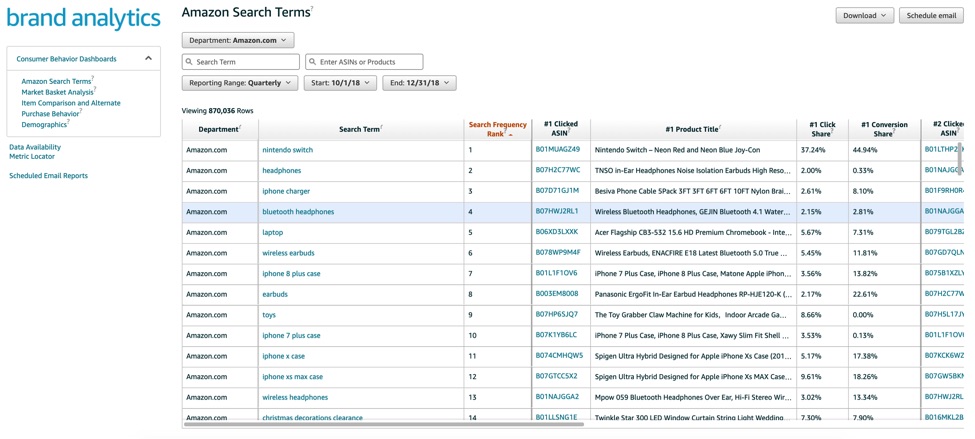There are now over 100 million Amazon Prime members in the U.S. Selling on the Amazon Marketplace is a huge opportunity, especially for brands. The all-important holiday selling season on Amazon in begins in early November. Start preparing now with the following four steps.
Merchandising
Develop your merchandising plan. Review your sales reports to see the items that perform well. Focus on the products that generate revenue and profit. Time is valuable. Concentrate on the listings that provide the highest return for your efforts.
With Amazon Brand Analytics, you can review current and historical data for Amazon’s entire Marketplace and drill down to your specific products. The statistics go back for several years. Use this information to look for missed opportunities from previous seasons and, also, to see where competitors excelled.

Use Brand Analytics’ reports to review data for Amazon’s entire Marketplace and for your specific products. Click image to enlarge.
The screenshot below is a “Market Basket Analysis” report, which is the most useful for me. It shows items that customers have purchased from other sellers.

The “Market Basket Analysis” report shows items that customers have purchased from other sellers.
Sales Projections
Your merchandising plan focuses on items that maximize profits. Next, project your sales in units. Creating projections will keep your team focused on the same sales goals.
Be aggressive with your goals. There are many sales opportunities during the holiday season. Project each one. The season begins in the first week of November and peaks during the weekend of Black Friday and Cyber Monday.
After Cyber Monday, Amazon offers weekly promotions, sales, and events in which independent brands can participate.
Inventory Needs
Inventory planning is critical to hitting your sales goals. Many brands fail at this, however. I have seen Fortune 100 companies run out of inventory on Amazon during the holidays, costing hundreds of thousands in lost sales. But I’ve also seen small companies double their sales and increase brand visibility with careful preparation.
Amazon is flooded with deliveries during the holidays. It’s not unusual for inventory to sit in trailers for weeks, waiting to be received.
Thus it is essential that your inventory arrive before you need it — not later than the second week of October. This will ensure that you have plenty of stock during the sales surge. It will also provide time to restock, if necessary.
Amazon charges long-term storage fees for excess inventory. Avoid these fees with accurate projections (and strong sales).
Advertising
Budget for advertising. During the holidays, advertising click costs increase by two or three fold. It’s essential to spend your advertising budget wisely to maintain a profitable ACoS — advertising cost of sales. Amazon will bombard brands and other sellers with options to participate in Lightning Deals, Black Friday Deals, and Cyber Monday sales — for a fee.
In my experience, these deals are helpful for specific categories, including high-end products, electronics, and video games. Before participating in any holiday promotion, calculate a profitable payback for your items.
Remember, you can use Amazon’s ad platform on other websites. For example, I’ve driven meaningful holiday Marketplace sales by placing ads from Amazon Advertising on Facebook and Instagram. The ads offer holiday discounts on my products; I tag the ads as “Black Friday deals” or “Cyber Monday deals” to track their performance. Ads on social media are typically less expensive than on Amazon itself. Thus I can bolster my Marketplace sales and avoid higher advertising costs.
Even if your ads work well throughout the year, create new campaigns for the holidays. Run several ad variations for each product. Advertise your brand storefront during the holidays, as well. Set up storefront ads from Sponsored Brands campaigns.